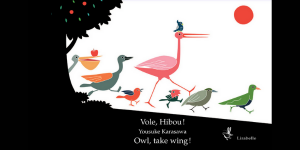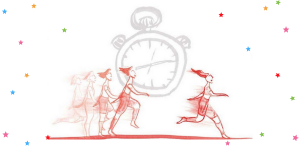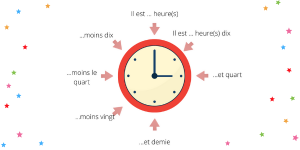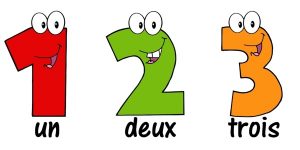Teach French to children by reading stories

Whether French is the native language of your child, or his second or third language, learning languages from an early age participates in their development and opens the child to a diverse world, full of opportunities. In this article, we’ll explore how to teach French to young children, emphasizing on creating a proper learning environment and using appropriate resources.
How to help a child learn French?
At any age, learning a language requires hard work, and many different methods exist online to make it easier. However, did you ever ask yourself what is the best method to learn French? For young learners, the best method remains immersion. Just like learning any language, it is easier to get familiar with the new sounds in your everyday life, to assimilate them faster.
We then recommend speaking, singing, and playing with your child in French, from a very early age. Young children benefit from great linguistic flexibility, permitting them to acquire new sounds and words with ease. If your child is not raised in a francophone environment, it remains essential to regularly speak French with them, especially before the age of 5.
Discover our selection of bilingual books to learn French.
Learning French through games
To teach French to young children, their interests should be privileged and put forward, as well as funny and playful methods. A very simple way consists of playing in French with the child, which allows them to learn without even noticing it! You’ll find many games in French online as well as in stores, to learn naturally and effortlessly. Dedicate a daily time of the day to playing in French to familiarize the kid with the language and create fond memories, shared together.
Learn French through nursery rhymes
If learning French for youngsters is a great method, what’s even funnier than nursery rhymes? We all know them by heart, and they all hold strong messages about diverse subjects. Toddlers and young children love them and learn them easily thanks to their lively melodies. Nursery rhymes are then a simple and playful method to teach French and its vocabulary to children. As the melodies are used in many languages with different translations, these songs help the ears get familiar with new sounds, without making any effort.
Read also our article on Nursery rhymes in French.
How to learn French at home?
To teach French to children, games and nursery rhymes are great, but to deepen the learning, think of reading! Literature for children is extremely rich and diverse, offering books on various subjects; your child will find what they like. During the bedtime story, for example, read beautiful stories in French. Establish a daily habit to read in French, to captivate the child and make them want to read more. If your kid does not know how to read yet, audiobooks offer a great immersive, and unique experience. The digital library Storyplay’r has a rich and diverse catalog of French books with an audio version and activities around the books.
Discover Storyplay'r's catalog.
Storyplay’r’s selection to learn French with young children
Petit et Grand – On s’aime quand même
from Kilowatt publishing
You are small and I am big… So what? We love each other anyway!
Discover all books from the collection On s’aime quand même to learn while having fun.
Read and listen « Petit et grand » on Storyplay’r.
Mes 100 premiers véhicules
by Anne Paradis & Annie Sechao
from CrackBoom! Livres
A beautiful picture book to discover the 100 first vehicules.
This book also exists in English: 100 first vehicules and things that go.
Read and listen « Mes 100 premiers véhicules » on Storyplay’r.
Les mots, ça compte un peu, beaucoup, énormément…
by Rhéa Dufresne & Sébastien Chebret
from éditions du Ricochet
A proper little manual of good manners to facilitate exchanges, fluidify communication, or resolve conflicts. These little words for everyday life, to feel good and do good!
Read and listen « Les mots, ça compte un peu, beaucoup, énormément… » on Storyplay’r
À quoi ça sert ?
from Zoom publishing
With our heads and hands, we perceive everything around us. But what is it for? The vocabulary of the senses from the earliest age.
Discover all the books from the collection Dents de Lait, to learn vocabulary.
Read and listen « À quoi ça sert ? » on Storyplay’r.
Plein de points
from Beurre Salé publishing
A graphic book for toddlers to teach them to spot the round shape in the world around them.
Read and listen « Plein de points » on Storyplay’r.
Les Fables de la Fontaine
by Jean de La Fontaine & Servan Legoff
from ZéTooLu publishing
The Fables de La Fontaine are timeless tales of the French language, for children and grown-ups to enjoy… With their rhymes and funny characters, they’re a great way to interest young ones.
Read and listen « Les Fables de la Fontaine » on Storyplay’r.
Nappe comme Neige
from Notari publishing
In this alphabet book, on the left-hand pages, each letter is associated with the image of an object: A for Aubergine, B for Bottle, etc. But then – and this is the originality of this book – on the right-hand page each object is re-enacted or diverted, sometimes by becoming part of another object, sometimes by transforming itself into another object.
Read and listen « Nappe comme Neige » on Storyplay’r.
Storyplay’r, a tool to learn how to read French
The online library Storyplay’r, used by many schools across the world, like the FLAM network (Français Langue Maternelle) or AEFE with many Lycées Français, offers many functionalities to learn how to read. Discover the various ways to use our platform. With offers for families, schools, or libraries, on all supports (computer tablet, smartphone), we work towards making reading accessible to all children. Our catalog has more than 1.800 books with activities and an audio version, to make reading fun for everyone.
Our reading aid tools
On all the books of our catalog, you will find different functionalities made for children learning how to read or with disabilities. These tools are on the audio as well as on the text display. We offer the recording of the voice so that children will improve their pronunciation and fluidity, a vocal assistant, and a listening mode in karaoke. For the text display, you’ll find many fonts, including OpenDyslexic, line/word/letter spacing as well as alternated colors of lines and words. Moreover, a reading ruler to simulate the natural way children are reading; colorization of sounds and letters, and the greying-out of mute letters to facilitate the assimilation of French grammar.
Learn more about our reading aid tools.
Bilingual French-English books

It might appear difficult to raise your children between two cultures, ensuring that they master both languages, especially when they do not practice them everywhere. Reading bilingual French-English books allows children to navigate between the two languages as they please.
Months in French

You might already know French numbers or French days of the week, but what about French months? When learning a new language, it is crucial to begin with days and months, as you might have to use them every day. For example, when taking appointments and dealing with deadlines.
As in English, most of the French months of the year are inspired by the Roman calendar, but with a few twists and turns of course! Below is a summary. We will explain each word in more detail.
● January is “Janvier”
● February is “Février”
● March is “Mars”
● April is “Avril”
● May is “Mai”
● June is “Juin”
● July is “Juillet”
● August is “Août”
● September is “Septembre”
● October is “Octobre”
● November is “Novembre”
● December is “Décembre”
French days of the week

Learning the days of the week in French is an easy and common first step to discovering this complex language. It may also be useful if you plan on having meetings or traveling to French-speaking countries. What’s more, children tend to start by learning the alphabet, numbers, and days of the week.
Telling time in French

You might already know your French months and days of the week, but what about telling time in French? What are AM and PM in French? How do you schedule an appropriate time for an appointment? You might have to review your French numbers before diving into telling time in French! Let’s get going! The picture of the clock here is just a brief overview. Don’t worry, we’ll explain it all!
Nursery rhymes in French

Nursery rhymes are a great way to introduce your children to French numbers, days of the week, animals… while having fun. As little children are natural musicians, singing will help them memorize new things and discover French culture without even realizing it! Maybe you are nostalgic for your own nursery rhymes, too!
French bedtime stories

Trying to teach French language and culture to your children? What could be better than reading them French fairy tales and bedtime stories? You can still count sheep, but you might have to review your French numbers before that!
French numbers for children and beginners

Counting is one of the first things you learn in a foreign language. It is also obviously very useful. There are no shortcuts to learning French numbers; you have to memorize them, by reading a story, playing a game, or singing a nursery rhyme, for example. If you are starting from scratch, you may be interested in My First Counting Book.
In addition to counting in French, you may also be interested in learning the following with Storyplay’r’s French stories for children:
First let’s take a look at numbers from one to ten, then from eleven to sixteen (why sixteen, you ask? Keep reading to find out!), before learning a few rules on counting in French, such as how to use a hyphen, exceptions, and how to count to 100.
Along the way, you will not only learn how to write these numbers, but we’ll also give you some pronunciation tips and rules.
Counting in French: numbers 1-10?
Good news, you already know the first number, which is not one, but zero—“zéro” in French. You just have to add an accent on the “e”, which makes the very French “é”, as in “café”.
Let’s take a look at the other numbers. We’ll explain the pronunciation of each one, and then give you a clear grid to memorize them more easily.
- ● One is “un”.
● Two is “deux”. Tricky one! You don’t pronounce the “x”!
● Three is “trois”. You still don’t pronounce the last letter, « s ». It’s just “tr-wa”. You have to get used to the French « r » sound, which does not exist in English.
● Quatre, “four”, also includes the « r » sound.
● Five is “cinq”. You don’t need the « u » after the “q” this time, unlike in “quatre”. There are only two words like that in French: “cinq” (five) and “coq” (rooster).
● Six is “six”. Looks the same, but you don’t pronounce the “x” as in English. Here, it sounds like an “s”.
● Seven is “sept”. You don’t pronounce the “p”.
● Eight is “huit”. You don’t pronounce the “h”.
● Nine is “neuf”. Here, you pronounce all the letters (Finally!).
● Ten is “dix”. It sounds similar to “six”, the final “ix” making the same sound.
Congratulations, you’ve learned eleven French numbers! By the way, how do you say eleven? Be patient and read the next paragraph…
Counting in French: numbers 11-16
You will have to learn French numbers from eleven to sixteen by heart, as there is no simple and easy logic.
French numbers from eleven to sixteen are special numbers and all contain a “z”:
- Eleven is “onze”.
- Twelve is “douze”. Think of “une douzaine”, which sounds like and means the same as “a dozen”.
- Thirteen is “treize”.
- Fourteen is “quatorze”. French people also use the term “quatorzaine”, which means a two-week-long quarantine. It is derived from the French word for quarantine, “quarantaine” (close enough)!
- Fifteen is “quinze”.
- Sixteen is “seize”.
Counting in French: numbers 17-69
After sixteen, French numbers go back to following a more logical pattern. They are just composed of the corresponding multiple of ten (ten, twenty, thirty, etc.) followed by a hyphen, then a number between one and nine. This is why we call them hyphenated numbers.
There is actually an exception to this rule (this is French after all, it can’t be all too simple!) for 21, 31, 41, etc. but we’ll get to that later.
Usually, the hyphenated numbers follow this rule:
- Seventeen is « dix-sept« . It is pronounced /dee-set ».
- Eighteen is “dix-huit”.It is pronounced “deez-weet”, because you link the “dix” sound to the next word, which begins with “hu”, considered as a vowel because the h is silent. In French, it makes the “z” sound, and is called a “liaison”.
- Nineteen is “dix-neuf”.Similarly, there is a “z” sound appearing between “dix” and “neuf”, even though “dix” on its own ends with the “s” sound.
As for the twenties:
- 20: vingt
- 21: vingt-et-un
- 22: vingt-deux
- 23: vingt-trois
- 24: vingt-quatre
- 25: vingt-cinq
- 26: vingt-six
- 27: vingt-sept
- 28: vingt-huit
- 29: vingt-neuf
Have you noticed the exception for 21? Instead of saying “vingt-un”, as the logic may suggest, you must say “vingt-et-un”, with the addition of « et », meaning « and ». In terms of pronunciation, there is another “liaison” between “vingt” and “un”: in “vingt” on its own, the “t” is silent. However, when there is a link between “vingt” and another word, you pronounce the “t”.
The same logic applies for thirty-one (“trente-et-un”), forty-one (“quarante-et-un”), up to sixty-one. Thus, the numbers 30 to 69 follow the same pattern.
The thirties:
- 30: trente
- 31: trente-et-un
- 32: trente-deux
- 33: trente-trois
- 34: trente-quatre
- 35: trente-cinq
- 36: trente-six
- 37: trente-sept
- 38: trente-huit
- 39: trente-neuf
The forties:
- 40: quarante
- 41: quarante et un
- 42: quarante-deux
- …
- 49: quarante-neuf
The fifties:
- 50: cinquante
- 51: cinquante et un
- 52: cinquante-deux
- …
- 59: cinquante-neuf
The sixties:
- 60: soixante
- 61: soixante et un
- 62: soixante-deux
- …
- 69: soixante-neuf
Counting in French: numbers 70-99
With French numbers 70 to 99, things get even more complex. Rather than using direct French equivalents of seventy, eighty, and ninety, the French use:
- the equivalent of “sixty-ten” (“soixante-dix”) for seventy, because seventy is sixty plus ten;
- “four-twenty” (“quatre-vingts”) for eighty;
- and “four-twenty-ten” (“quatre-vingt-dix”) for ninety.
And it’s only valid in France! In other French-speaking countries such as Switzerland, they do use equivalents of seventy (“septante”), eighty (“octante”) or ninety (“nonante”)!
Be careful: “quatre-vingts” ends with an “s” when it is not followed by another number. The “s” disappears if a number follows. For instance, in “quatre-vingt-deux” or “quatre-vingt-dix”, “vingt” does not end in an “s”.
It’s getting difficult, isn’t it? Brace yourself, there is more to come!
You might remember that “one” was an exception from 21 to 61 (“vingt-et-un” to “soixante-et-un”) and that 11 was “onze”. We will use a fusion of the two for 71 and 91, which give “soixante-et-onze” and “quatre-vingt-onze”.
But what about 81? It does not have an “et”. You will then say “quatre-vingt-un” instead of “quatre-vingt-et-un ». Also, keep in mind that the “t” remains silent.
You are not done yet! From 70 to 100, all the numbers use their “10” equivalent. Then, 72 in French is “soixante-douze” (the equivalent of “sixty-twelve”). And, indeed, 72 is sixty plus twelve! 73 is “sixty-thirteen”, 74 is “sixty-fourteen”, and so on.
It’s the same for 90 to 100: 91 is “quatre-vingt-onze” (“four-twenty-eleven”), 92 is “quatre-vingt-douze” (“four-twenty-twelve”). But this isn’t the case for the 80s. Except 81, or “quatre-vingt-un”, there are only simple hyphenated numbers: 82 is “quatre-vingt-deux” (“four-twenty-two”), 83 is “quatre-vingt-trois”, 89 is “quatre-vingt-neuf”.
Below is a summary table. Take time to memorize all the new rules and exceptions.
Seventies:
- 70: soixante-dix
- 71: soixante et onze
- 72: soixante-douze
- 73: soixante-treize
- 74: soixante-quatorze
- 75: soixante-quinze
- 76: soixante-seize
- 77: soixante-dix-sept
- 78: soixante-dix-huit
- 79: soixante-dix-neuf
Eighties:
- 80: quatre-vingts
- 81: quatre-vingt-un
- 82: quatre-vingt-deux
- 83: quatre-vingt-trois
- 84: quatre-vingt-quatre
- 85: quatre-vingt-cinq
- 86: quatre-vingt-six
- 87: quatre-vingt-sept
- 88: quatre-vingt-huit
- 89: quatre-vingt-neuf
And the nineties:
- 90: quatre-vingt-dix
- 91: quatre-vingt-onze
- 92: quatre-vingt-douze
- 93: quatre-vingt-treize
- 94: quatre-vingt-quatorze
- 95: quatre-vingt-quinze
- 96: quatre-vingt-seize
- 97: quatre-vingt-dix-sept
- 98: quatre-vingt-dix-huit
99: quatre-vingt-dix-neuf
Counting in French: 100-1,000
Just like a hundred in English, 100 has its own word in French which is “cent” and counting above 100 is fairly easy. Between 100 and 200, you just have to put “cent” in front of the corresponding number between 1 and 100. Here are a few examples:
- 1 is “un”, 101 is “cent-un”.
- 11 is “onze”, 111 is “cent-onze”.
- 34 is “trente-quatre”, 134 is “cent-trente-quatre”.
After that, it’s quite easy until 1,000. Below are some examples to help you understand:
- 200 is “deux-cents”
- 300 is “trois-cents”
- 201 is “deux-cent-un”
- 401 is “quatre-cent-un”
- 234 is “deux-cent-trente-quatre”
- 734 is “sept-cent-trente-quatre”
Counting in French: numbers over 1,000
Just like a thousand, 1,000 has its own word in French, which is “mille”, and counting above 1,000 is easy. Just put « mille », « deux-mille », « trois-mille » and so on, in front of the corresponding number between 1 and 1,000. As before, here are some examples to illustrate:
- 1 is “un”, 1,001 is “mille-un”, 2,001 is “deux-mille-un”
- 101 is “cent-un”, 1,101 is “mille-cent-un”
- 11 is “onze”, 1,011 is “mille-onze”, 2,111 is “deux-mille-cent-onze”
Practice French numbers with Storyplay’r’s French stories for children
Learn the other French numbers with our digital books. Take a look at these two stories with numbers: 10 moutons 9 dinosaures, by Maria Jalibert, and Compter avec un monstre, by Patrick Pasques.
There are also a lot more to choose from on Storyplay’r to practice French numbers and we even have a category of stories called Counting with French stories.
Reading and listening to a book on Storyplay’r will help you learn to count in French faster and more effectively. Even if you don’t understand everything yet, you will be able to follow the story thanks to the text and accompanying illustrations. Plus you’ll be practicing your listening comprehension skills without even realizing it!












